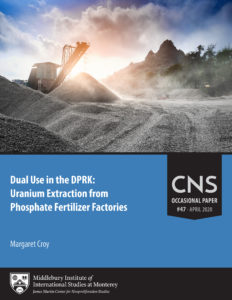April 6, 2020
by Margaret Croy
Several states have succeeded in extracting “yellowcake” uranium from phosphoric acid as part of the phosphate fertilizer production process. The Democratic People’s Republic of Korea (DPRK) has both the means and motivation to undertake such work, thus significantly altering existing open-source assessments of how much yellowcake uranium North Korea could produce annually, which in turn affects estimates of how many nuclear warheads DPRK can make.
There is ample rationale for the DPRK to pursue this method of uranium extraction. The dual usage of existing infrastructure would both conceal the activity and make it more difficult for international audiences to positively identify and condemn. The DPRK certainly needs fertilizer, and the information on how to extract uranium from its production is readily available. Lastly, this method of yellowcake production embodies the policy of byungjin—parallel nuclear-weapon development and economic expansion—a hallmark of Kim Jong Un’s strategy. Given these factors, the rationale for the pursuit of this method is clear. The evidence is even more so.
The first section of the paper explains the science behind uranium extraction from phosphoric acid produced as an intermediary in the production of fertilizer from phosphate rock. The second section highlights some of the historical cases of states using this method to obtain uranium. The third section elucidates the reasoning and rationale for using this method in the DPRK, and the fourth section examines the open-source evidence available indicating that this method of obtaining uranium—however uncommon—is in use in the DPRK today, and is likely to continue and expand in scale.
About the author
Margaret (Maggie) Croy conducts research for the East Asia Nonproliferation Program (EANP) at the James Martin Center for Nonproliferation Studies (CNS) at the Middlebury Institute of International Studies at Monterey (MIIS). Croy uses remote sensing technologies, data analytics tools, and traditional research methods to study a variety of topics, including North Korean WMD proliferation, military facilities across the Middle East, the nuclear fuel cycle, and compliance with multilateral nonproliferation and arms-control treaties. Previously, Margaret worked as a graduate research assistant at CNS, a political affairs intern at the United Nations Office for Disarmament Affairs, an international nuclear safeguards policy intern at Lawrence Livermore National Laboratory, and as an analyst at the Center for Homeland Defense and Security at the Naval Postgraduate School. Margaret graduated from MIIS in 2018 with an MA in Nonproliferation and Terrorism Studies. Previously, she earned her AB in Anthropology from Dartmouth College in 2014. Margaret has also taken part in several specialized training courses, including the International Nuclear Safeguards Policy and Information Analysis course hosted by CNS in conjunction with LLNL, the Nuclear Research Reactor Practicum course at the Czech Technical University Department of Nuclear Reactors, and the Middlebury Summer Intensive Language Program in Arabic.

